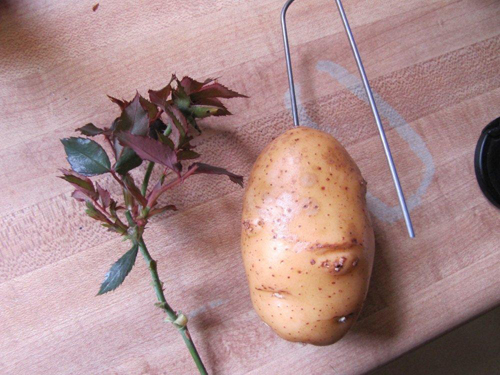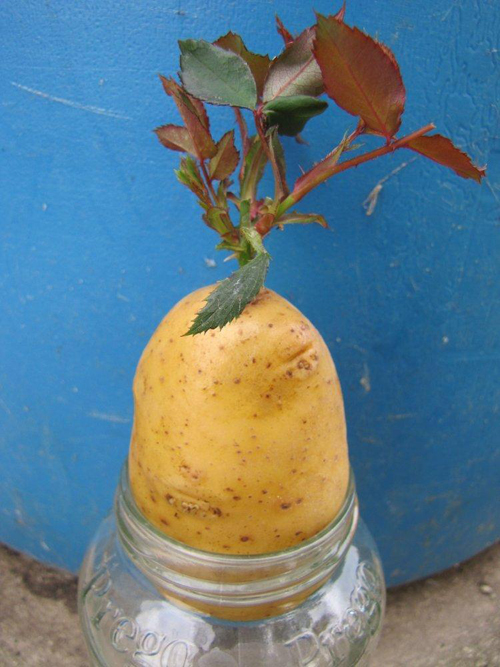Cutting roses in potatoes
The luxurious relative of the humble rose hips - the rose - has always been in favor, both among kings and commoners. Now roses can often be seen on the backyards of many amateur flower growers, in city parks and squares. Breeders are working tirelessly to give people new, unique varieties of these plants.

There are many ways to reproduce roses, for example, by grafting wild rose on seedlings, dividing a bush, etc. No less interesting is the production of own-rooted plants - from cuttings. Roses grown from cuttings retain all varietal characteristics, since they are, in fact, clones.
Harvesting and preparation of planting material
Novice flower growers are often interested in whether it is possible to grow a favorite variety from a gift bouquet? You can grow, but is it worth it? Firstly, briquetted roses are often treated with special chemical preservatives that block root formation. Secondly, even if rooting is successful, it is not yet a fact that the resulting plant will feel good in a flower garden. To obtain self-rooted roses, experienced florists prefer to take zoned varieties, that is, adapted to the climatic conditions of the region.
The first two months of summer are the ideal time for cutting roses. As a rule, it is started shortly before budding, in extreme cases - immediately after flowering. For harvesting planting material, it is necessary to choose shoots of the second year - dense, green, with a brownish tint, which indicates the beginning of lignification. The thorns of a mature shoot should break off easily.

The cut shoots must be divided into several segments so that each cuttings have 3-4 growth buds. The upper and lower parts of the shoot are removed, since the diameter of each cutting should be approximately 7-10 mm. Having departed from the lower kidney 2-3 mm, an oblique cut is made with a sharp knife (at an angle of 45 degrees). The upper cut is straight, 1.5-2 cm above the kidney.
It is recommended to cover the upper cut of the cutting with wax or garden varnish - this is done so that pathogenic bacteria and spores of pathogenic fungi do not get through the place of damage, as well as in order to minimize moisture loss. Further, all thorns are removed from the cutting, as well as the lower leaves, leaving only the upper pair. Professionals also recommend trimming the leaves left by 1/3 - ½ - this technique allows you to reduce moisture loss.
Rooting methods for cuttings
Various techniques have been developed for rooting rose cuttings, each of which has its own advantages and disadvantages. For example, rooting can be carried out in water, in soil ("Trannois method"), in an inert material (vermiculite, cotton wool, wet paper - "burrito method"), etc. Recently, the method of rooting in potato tubers, characterized by high efficiency. Firstly, the temperature and humidity conditions are easily ensured inside the tuber. Second, the cutting gets all the nutrients it needs. Thirdly, the process of callus formation is activated, from which roots subsequently develop.

Rooting cuttings in potatoes
- Site preparation. A well-heated and illuminated area is allocated for the greenhouse. In the place of the alleged cuticle, trenches are dug 20-25 cm wide and deep on the bayonet of a shovel. The bottom of the trench is covered with a layer (about 5-7 cm) of river sand or expanded clay to ensure good drainage. Next, the trench is filled with fertile soil (a mixture of garden soil and inert peat).
- Pre-planting processing of cuttings.Before planting, it is recommended to soak them for 2-3 hours in a solution of any root formation stimulant (Epin, Zircon, heteroauxin). Immediately before planting, the lower cut of the cutting should be powdered with Kornevin powder.
- Preparation of potato tubers. In potatoes intended for rooting cuttings, it is necessary to cut out all growth buds ("eyes"). Next, a puncture is made in the potato (for example, with a screwdriver) 3-4 cm deep. Some growers prefer to use greened tubers, for which they are kept for 5-7 days in sunlight.
The final stage - "charging the tubers": gently push the stalk into the hole made in the potato so that the lower bud is inside. Next, place the tubers in a trench and cover with soil 2/3 of the length of the cutting. The distance between tubers is 15-20 cm.
Arrangement of a cuticle for roses
To ensure optimal temperature and humidity conditions, the cuttings must be equipped with metal arcs and covered with plastic wrap. Periodically (3-4 times a day), the cuttings should be sprayed with water from a spray bottle. Watering the soil is carried out every 5 days. For irrigation, it is better to use rainwater, adding 4 tsp for each liter. Sahara.
As a rule, cuttings of roses in potatoes take root in a month - from this moment they begin to harden the seedlings, periodically removing the polyethylene, increasing the airing time every day. After two weeks, the plastic wrap is removed completely.
Young plants are planted in a permanent place at the beginning of September, mulching the planting pits with sawdust (fallen leaves, spruce branches) to protect the roses from the winter cold.








